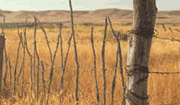|
||||||||||||||||||||||||||||||||||||||
 The Culture of the Fence: Artifacts and Meanings By Christina Kotchemidova Studying the history of the fence poses some ontological and epistemological problems. On the one hand, fences are tangible objects that have been put to use at all times for definite purposes. On the other, they are artifacts having meanings in the cultural systems they have been employed in. A functional analysis should involve studying both the virtual ramifications of a medium on people’s way of life and its symbolic usage in their societies. The fence only exemplifies the role of technologies in culture. As Marshall McLuhan showed, while technologies enable us to do things, i.e. to act or behave in certain ways, they also make us think about what we do in certain ways, thus creating habits of thought. Hence, our practices, built upon the media we use, shape up our conceptualization of the world. With continuous usage technologies highlight what is important to think about in our lives thus establishing cultural values. Culture then perpetuates itself by employing practices as symbols. From this perspective studying the history of the fence is at the same time studying the culture of the fence. While the volume of this essay allows me to offer no more than fragmented evidence from a small number of societies, epochs and locations, I will attempt to show how the use of fences in human societies has generated myths we live by and ideologies we now take for realities.
The history of civilization is closely tied with the history of the fence. Human civilization is conceptualized as emerging from agriculture, family and property. All of these evolved with the fence. In the early stages of settling human tribes tended to till the land in a group. Caesar, in Gallic War describes how amongst the ancient Germans "there were no separate estates or private boundaries." Tacitus elaborates that the Germans practiced the so-called "shifting cultivation" -- making a plantation, reaping the crop and then moving on. This kind of land usage does not need fences but in the long run it leads to wide-range destruction of woods and severe soil erosion so it is usually called "predatory cultivation" or "land-mining." The appearance of the fence in human societies marked the transition from a pattern of looting nature to taking care of it. It was with devoted agriculture that fences came about. While it is impossible to name the inventor of this technology back in Ancient Mesopotamia, Rousseau curiously alludes to him saying: "The first man who, having fenced in a piece of land, said "This is mine," and found people naïve enough to believe him, that man was the true founder of civil society.” The fence helped institutionalize one of the most important elements of the social contract – the collective recognition of private property. Being instrumental in the culture of property, the fence fostered long-term thinking and constructive effort. As the great English agriculturist Arthur Young said commenting on eighteenth century French peasants’ toil on their small patrimonies, “Give a man the secure possession of a bleak rock and he will turn it into a garden. Give him a nine years' lease of a garden and he will convert it into a desert." Land-ownership demanded lasting commitment and care that were beyond the capacity of a single individual, so since very early on land was attached not to the individual but to a family. In early Hindu and Greek law land could not be sold or transferred to another family, either by bequest or as a dower. A father who had land was compelled to leave it to his sons. If he had no sons he must pass it to the nearest relation. Since no one could take away family land upon marriage, the fence was associated with native home and was historically embedded in a patriarchal domestic context. Having a strong visibility bias, the fence is an open declaration of intention. It says on the part of an occupant "I am here and planning to stay." This makes it an appropriate device to be associated with law. Numa, the second king of Rome laid down in 7th century B.C. that each man should surround his land with a boundary and set up landmarks of stone. He dedicated these landmarks to the god Terminus, and ordained that sacrifices should be offered up to him every year, appointing the festival of the Terminalia. This worship of boundaries was meant to celebrate the conquest of the land of Rome from the Latinians and the Sabines originally occupying the region. In the Roman context, the victory would not have been possible without the will of the gods. The symbols of this victory had to be honored in appreciation of the gods' benevolence. Thus the fence was invested with meaning and gained value. |
||||||||||||||||||||||||||||||||||||||
|
:: I. M. Pei's La Pyramide du Louvre: A Diamond in
the Rough or Merely Junkspace? By Rebecca L. Moyer :: The Culture of the Fence: Artifacts and Meanings By Christina Kotchemidova :: On the Significance of Death in Culture & Communication Research By Charlton McIlwain, Ph.D. | ||||||||||||||||||||||||||||||||||||||
|
:: Swept Away By An Unusual Destiny In The Blue Sea Of August: Lina Wertmüller, 1974 - Guy Ritchie's Swept Away 2001 By Laura Meucci :: What Do I Get? Punk Rock, Authenticity, and Cultural Capital By Brian Cogan The Osbournes': Genre, Reality TV, and the Domestication of Rock 'n Roll By Rick Pieto and Kelly Otter |
||||||||||||||||||||||||||||||||||||||
| ::
About Contributors |
||||||||||||||||||||||||||||||||||||||
|
||||||||||||||||||||||||||||||||||||||
| About :: Archive :: Staff :: Submit :: Contact | ||||||||||||||||||||||||||||||||||||||









